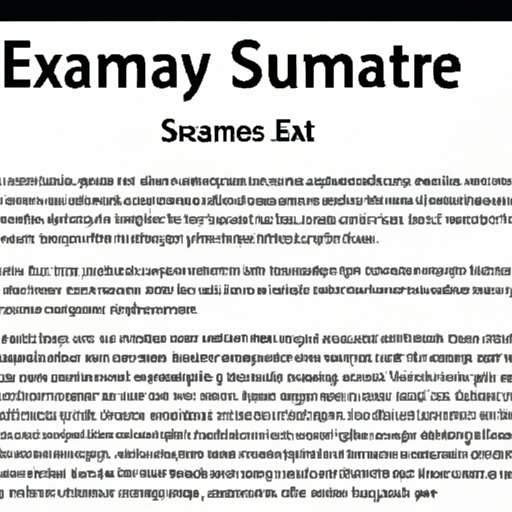Introduction
An executive summary is a concise overview of a larger document or report that highlights its key points. It helps busy readers quickly understand the main points of a document without having to read it in full. The purpose of an executive summary is to provide an accurate and succinct description of the contents of a document.

Essential Steps for Creating an Executive Summary
To write an effective executive summary, there are several essential steps to consider.
Gather the Necessary Information
The first step in creating an executive summary is to gather all the necessary information. This includes any relevant documents such as reports, presentations, research papers, or data. It’s important to do thorough research so that you have a comprehensive understanding of the topic and all its components.
Analyze and Organize the Information
Once you have all the necessary information, the next step is to analyze and organize it. This involves breaking down the larger document into its main points and sub-points. Highlight any important facts, figures, or ideas that you think should be included in the executive summary.
Identify the Main Points
Finally, after analyzing and organizing the information, it’s time to identify the main points. These are the most important elements of the document that you want to highlight in the executive summary. Make sure to include any key findings, conclusions, or recommendations that were made.

Tips on What to Include in an Executive Summary
When writing an executive summary, there are certain tips to keep in mind.
Use Clear, Concise Language
It’s important to use clear, concise language when writing an executive summary. Avoid using jargon or overly complex words that may confuse the reader. Instead, focus on using simple language that is easy to understand.
Highlight Key Points
Make sure to highlight any key points or findings from the larger document. This will help to ensure that the reader understands the most important aspects of the document.
Keep it Short
The executive summary should be kept short and to the point. Try to limit it to one page if possible. If it’s too long, it will be difficult for the reader to get the main points.
How to Structure an Executive Summary
There are several ways to structure an executive summary.
Introduce the Topic
Start by introducing the topic and giving a brief overview of the document. This will give the reader an idea of what the document is about and why they should read it.
Present the Main Points
Next, present the main points of the document. This should include any key findings, conclusions, or recommendations. Make sure to provide enough detail so that the reader understands the most important aspects of the document.
Summarize the Conclusions
Finally, summarize the conclusions of the document. This should include any final thoughts or recommendations that were made.

Examples of Effective Executive Summaries
For some inspiration, here are three examples of effective executive summaries.
Example 1
This report examines the impact of social media on businesses. It discusses the opportunities and challenges of using social media, and outlines key strategies for success. The report concludes that businesses need to develop a comprehensive social media strategy to maximize the benefits and minimize the risks.
Example 2
This research paper looks at the current state of the healthcare industry. It examines the challenges faced by healthcare providers, as well as potential solutions. The paper finds that the healthcare industry needs to develop new technologies and processes to improve patient care and reduce costs.
Example 3
This presentation explores the global economy and its implications for businesses. It looks at the current economic environment, as well as potential risks and opportunities. The presentation concludes that businesses need to be agile and prepared for changes in order to remain competitive.
Conclusion
Writing an effective executive summary can be challenging, but with the right steps and tips, it can be done. Start by gathering the necessary information, analyzing and organizing it, and identifying the main points. Make sure to use clear, concise language, highlight key points, and keep it short. Finally, use examples of effective executive summaries for inspiration.
(Note: Is this article not meeting your expectations? Do you have knowledge or insights to share? Unlock new opportunities and expand your reach by joining our authors team. Click Registration to join us and share your expertise with our readers.)
